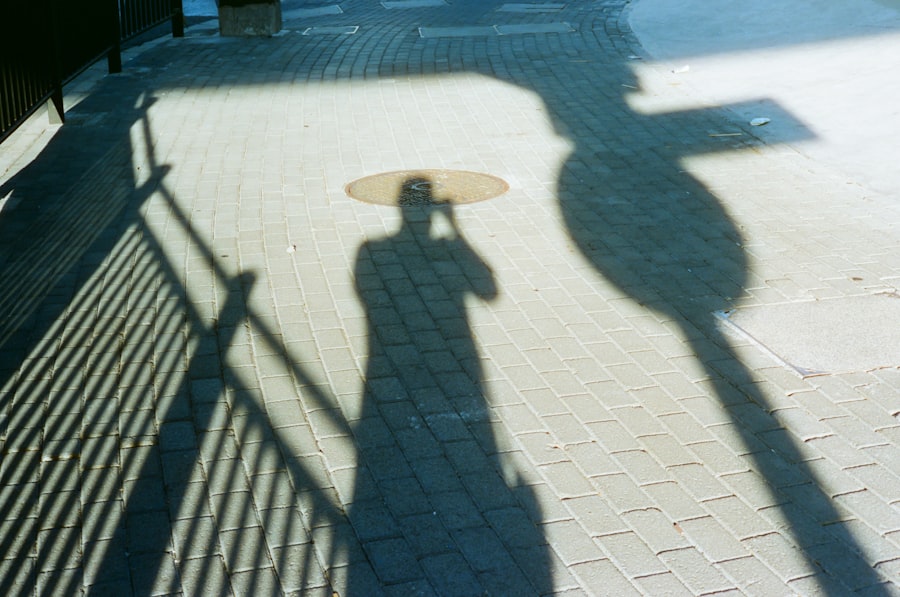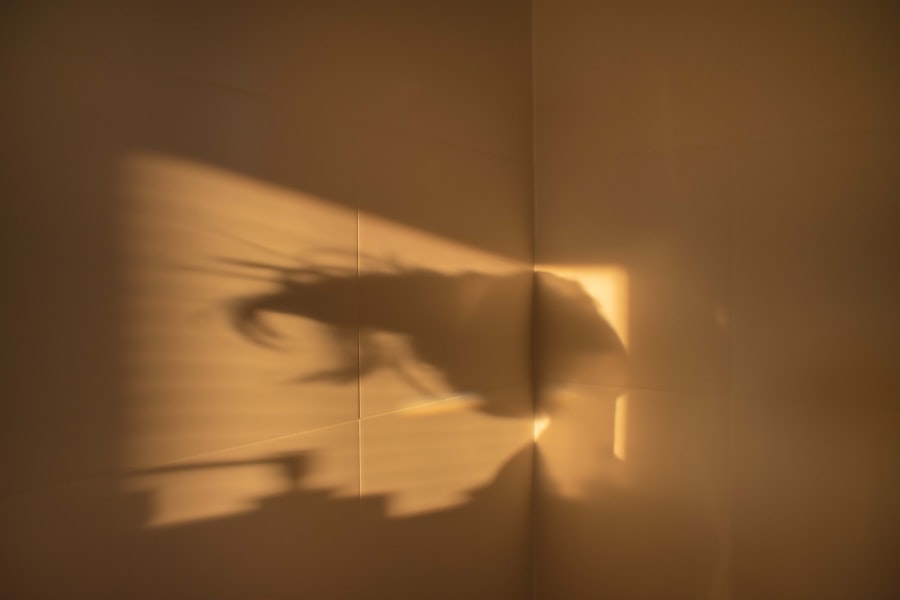Light and shadow are fundamental elements of our visual experience, shaping the way you perceive the world around you. Light, in its various forms, illuminates objects, revealing their colors, textures, and shapes. It is the source of visibility, allowing you to navigate through your environment.
Conversely, shadow is the absence of light, creating contrast and depth. When light strikes an object, it casts a shadow that can vary in intensity and shape depending on the angle and quality of the light source. This interplay between light and shadow is not merely a physical phenomenon; it also evokes emotional responses and influences your perception of space.
As you delve deeper into the nature of light and shadow, you may begin to appreciate their dynamic relationship. Light can transform a mundane scene into something extraordinary, while shadows can add mystery and intrigue. The way light interacts with surfaces can create a sense of movement or stillness, warmth or coolness.
Understanding this relationship allows you to see beyond the surface, recognizing how light and shadow work together to create a more nuanced understanding of your surroundings. This awareness can enhance your appreciation for art, photography, design, and even your daily life.
Key Takeaways
- Understanding the principles of light and shadow is essential for creating depth and dimension in art and photography.
- Light and shadow play a crucial role in shaping the mood and atmosphere of artistic compositions.
- Balancing light and shadow is key to capturing compelling and dynamic photographs.
- Creating depth and dimension in art is achieved through the strategic use of light and shadow.
- Light and shadow are powerful tools in interior design, influencing the perception of space and creating ambiance.
The Role of Light and Shadow in Art
In the realm of art, light and shadow play a pivotal role in conveying emotion and meaning. Artists have long utilized these elements to create mood and atmosphere in their work. When you observe a painting or sculpture, the way light interacts with the subject can evoke feelings ranging from serenity to tension.
For instance, the soft glow of light in a landscape painting may instill a sense of peace, while stark contrasts between light and dark can create drama and intensity. This manipulation of light and shadow is essential for artists seeking to communicate their vision effectively. Moreover, the techniques artists employ to depict light and shadow can vary widely.
Some may use chiaroscuro, a technique that emphasizes strong contrasts between light and dark to create a three-dimensional effect. Others might explore the subtleties of light through impressionistic brushwork, capturing fleeting moments of illumination. As you engage with different artistic styles, consider how each artist’s approach to light and shadow influences your emotional response to their work.
This exploration can deepen your understanding of art as a powerful medium for expression.
Balancing Light and Shadow in Photography

Photography is another field where the balance of light and shadow is crucial. As a photographer, you are constantly making decisions about how to harness these elements to create compelling images. The quality of light—whether it’s soft and diffused or harsh and direct—can dramatically alter the mood of your photographs.
You may find that shooting during the golden hour, when the sun is low on the horizon, produces warm tones and long shadows that add depth to your images. Conversely, shooting in harsh midday sunlight can create stark contrasts that may not always be desirable. In addition to natural light, artificial lighting can also be manipulated to achieve specific effects in your photography.
You might experiment with different lighting setups to highlight certain features or create dramatic shadows that enhance your composition. Understanding how to balance light and shadow allows you to tell a story through your images, guiding the viewer’s eye and evoking emotions. As you refine your skills in photography, consider how mastering this balance can elevate your work from mere snapshots to powerful visual narratives.
Creating Depth and Dimension with Light and Shadow
| Technique | Effect |
|---|---|
| Chiaroscuro | Creates strong contrast between light and dark |
| Backlighting | Creates silhouettes and adds depth to the subject |
| Side lighting | Emphasizes texture and creates dramatic shadows |
| Fill light | Reduces harsh shadows and adds detail to dark areas |
Creating depth and dimension in visual art relies heavily on the effective use of light and shadow. When you observe a three-dimensional object, such as a sculpture or a well-crafted painting, it is often the interplay of light and shadow that gives it form. By strategically placing highlights and shadows, you can create the illusion of volume and space on a flat surface.
This technique invites viewers to engage with the artwork more deeply, as they are drawn into its dimensionality. In your own artistic endeavors, consider how you can manipulate light and shadow to enhance depth. For instance, using lighter colors in areas where light hits an object can make those parts appear closer to the viewer, while darker shades can recede into the background.
This technique not only adds realism but also guides the viewer’s eye through the composition. As you practice creating depth with light and shadow, you may discover new ways to express your artistic vision and connect with your audience.
Using Light and Shadow in Interior Design
In interior design, the strategic use of light and shadow can transform a space from ordinary to extraordinary. As you curate your living environment, consider how natural light enters each room and how it interacts with various surfaces.
Conversely, well-placed furniture or architectural features can cast shadows that add depth and interest to the overall design. Moreover, artificial lighting plays a significant role in shaping the ambiance of a room. You might choose warm-toned bulbs for a cozy atmosphere or cooler tones for a more modern feel.
Layering different types of lighting—ambient, task, and accent—can create dynamic contrasts between light and shadow throughout your space. By thoughtfully integrating these elements into your design choices, you can cultivate an environment that reflects your personal style while also enhancing functionality.
The Psychological Impact of Light and Shadow

The psychological effects of light and shadow are profound and often subconscious. You may not realize it, but the way light enters a room or how shadows fall across a landscape can influence your mood and emotions significantly. Brightly lit spaces tend to evoke feelings of happiness and energy, while dimly lit areas may promote relaxation or introspection.
Understanding this psychological impact allows you to make more informed choices about your environment—whether at home or in public spaces. In addition to physical spaces, consider how light and shadow affect your emotional state in various contexts. For example, during moments of reflection or meditation, softer lighting may help create a calming atmosphere conducive to introspection.
Conversely, bright lights might energize you during social gatherings or creative endeavors. By becoming more aware of how these elements influence your feelings, you can harness their power to enhance your overall well-being.
Integrating Light and Shadow in Spiritual Practices
Light and shadow have long been integral to spiritual practices across cultures. Many traditions use these elements symbolically to represent dualities such as good versus evil or enlightenment versus ignorance. In meditation or mindfulness practices, for instance, practitioners often focus on the interplay between light and shadow as a metaphor for inner balance.
You might find that visualizing this contrast helps you cultivate awareness of your thoughts and emotions. In sacred spaces such as temples or churches, the use of natural light through stained glass windows creates an ethereal atmosphere that invites contemplation. The way light filters through these colorful panes casts vibrant patterns on the floor, reminding you of the beauty found in both illumination and darkness.
By integrating these concepts into your spiritual practices, you can deepen your connection to yourself and the world around you.
Embracing the Contrast of Light and Shadow in Life
Life itself is a tapestry woven from moments of both light and shadow.
When you acknowledge that both elements are essential parts of existence, you cultivate resilience and wisdom.
Rather than shying away from difficult times or seeking only happiness, you learn to find beauty in every experience. As you navigate life’s challenges, consider how moments of darkness can lead to personal growth or deeper understanding. Just as artists use shadows to enhance their work, you can use life’s trials as opportunities for reflection and transformation.
By embracing both light and shadow within yourself, you foster a sense of wholeness that enriches your journey.
Finding Harmony through the Art of Integration
Finding harmony between light and shadow involves recognizing their interdependence rather than viewing them as opposing forces. In art, photography, design, or even personal growth, integrating these elements creates balance that resonates with viewers or participants on multiple levels. You might explore this integration by experimenting with contrasting colors in your artwork or by creating spaces that invite both brightness and tranquility.
In your personal life, consider how integrating moments of joy with periods of introspection can lead to greater fulfillment. By allowing yourself to experience both sides of life’s spectrum without judgment or resistance, you cultivate an authentic existence that honors all aspects of who you are. This journey toward integration fosters resilience as you learn to navigate challenges while celebrating triumphs.
Techniques for Harmonizing Light and Shadow in Art
To harmonize light and shadow effectively in your artistic practice requires experimentation with various techniques tailored to your medium. If you’re painting or drawing, consider using gradients to transition smoothly between highlights and shadows—this creates a more cohesive look that draws viewers into your work. In photography, mastering exposure settings allows you to capture details in both bright highlights and deep shadows without losing information.
Additionally, studying works by master artists who excelled at balancing these elements can provide valuable insights into effective techniques for harmonization. Analyze how they used color theory or compositional strategies to create unity within their pieces; then apply those lessons within your own practice as you strive for balance between lightness and darkness.
The Beauty of Embracing Light and Shadow
Ultimately, embracing both light and shadow reveals profound beauty within our experiences—both artistic endeavors as well as everyday life moments filled with complexity. When you allow yourself to see beyond mere appearances—to recognize how these contrasting forces shape perceptions—you open yourself up to deeper connections with art forms around you while also enriching personal relationships. As you continue exploring this interplay throughout various aspects of life—from creative pursuits like painting or photography through spiritual practices—remember that true beauty lies not just within individual elements but rather within their harmonious coexistence together!
Embrace this duality wholeheartedly; it will lead you toward greater understanding not only about artistry but also about yourself along this journey called life!
Integrating the light and shadow aspects of our personality is a crucial step in achieving personal growth and self-awareness. An insightful article that delves into this topic can be found on Unplugged Psychology’s website. This piece explores how acknowledging and embracing both the positive and negative facets of our character can lead to a more balanced and fulfilling life. For a deeper understanding, you can read the full article by visiting Unplugged Psychology. This resource provides valuable perspectives on how to harmonize these contrasting elements within ourselves, ultimately fostering a more integrated and authentic self.
FAQs
What does it mean to integrate light and shadow aspects?
Integrating light and shadow aspects refers to the process of acknowledging and accepting both the positive and negative aspects of oneself. It involves embracing one’s strengths and weaknesses, and finding a balance between the two.
Why is it important to integrate light and shadow aspects?
Integrating light and shadow aspects is important for personal growth and self-awareness. By acknowledging and accepting all aspects of oneself, individuals can develop a more holistic understanding of their identity and experience greater emotional and psychological well-being.
How can one integrate light and shadow aspects?
Integrating light and shadow aspects involves self-reflection, introspection, and a willingness to confront and accept one’s vulnerabilities and flaws. This can be achieved through practices such as therapy, mindfulness, and self-exploration.
What are the benefits of integrating light and shadow aspects?
The benefits of integrating light and shadow aspects include increased self-acceptance, improved relationships, and a greater sense of authenticity and wholeness. It can also lead to enhanced emotional resilience and a deeper understanding of one’s motivations and behaviors.



